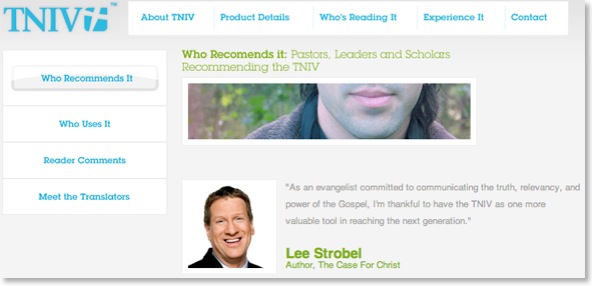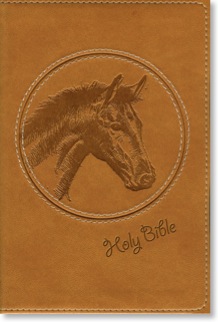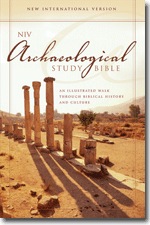Thoughts & Predictions on the 2011 NIV (and a Requiem for the TNIV)
http://thislamp.com/?p=1638
Please continue any discussion and redirect any known links to the above URL.
This Just In: the NIV to be Updated as "NIV 2011"; TNIV to be Discontinued
http://thislamp.com/?p=1645
Please continue any discussion and redirect any known links to the above URL.
YANIVB
“Of making many NIV Bibles there seems to be no end, and a lack of TNIV Bibles wearies my soul.”
(With apologies to Qoheleth and Ecclesiastes 12:12)
I took an online survey from Zondervan tonight for a YANIVB. What’s a YANIVB? Well, YANIVB stands for “Yet Another NIV Bible.” While the TNIV seems to be losing ground everyday, it seems that there’s no end in sight for new NIV Bibles.
The Bible in question here? Well, it’s based upon the work of Lee Strobel and called The Case for Faith Study Bible. It’s so early in development stage that if you run a Google search on this Bible right now--even if you put quotation marks around it--you won’t get any hits. At least if you run your search within a close timeframe for my writing this post.
The main thrust of the survey was to select which cover I liked best:

Incidentally, I liked the top right cover best and the bottom left cover second best.
Of course, as you would guess, I’ve got a HUGE problem with this Bible. No, it’s not the theme. For what it’s worth, I think Lee Strobel is a great guy, and I’ve given away some of his books. My problem with this Bible is that it’s a NEW Bible released with the NIV as its text rather than the TNIV.
I really don’t understand this. The NIV continues to cannibalize sales of the TNIV and lessen the latter’s chance of acceptance. It is clearly shortsighted for Zondervan to keep the NIV as its flagship translation to the neglect of the TNIV, to continue to promote NEW products based around the NIV while new TNIV projects are few and far between. One day the NIV will slip from its spot as bestselling translation, but it won’t be the TNIV to take its place because the TNIV will have died from neglect by that time.
But do you want to know what makes creating Lee Strobel’s Bible around the NIV most egregious?
Well, if you go over to TNIV.com, click on the “Who’s Reading It” tab, and then click on the “Who Recommends It” tab, guess who appears FIRST!
Thats right! There’s Lee Strobel, front and center, stating “I’m thankful to have the TNIV as one more valuable tool in reaching the next generation.”
Well, too bad, Mr. Strobel, we’re going to make you use the Bible of the last generation: the NIV!
I’ve said over and over that Zondervan needs to put strong testimonial power behind the TNIV for people to consider it. Lee Strobel and The Case for Faith Study Bible would be a perfect match for the TNIV. And yet, before it ever even sees print, it becomes another wasted opportunity for Zondervan to move its resources behind the TNIV. YANIVB is what it becomes. When will the tide turn?
Of course, for all of Lee Strobel’s wish for the TNIV to become a valuable tool in reaching the next generation, and for all of Zondervan’s original marketing of the TNIV as a Bible for the 18 to 34 crowd, can anyone tell me why The Student Bible has been revised since the release of the TNIV, and yet still remains an NIV Bible?
Here’s a new slogan: “TNIV: The Best Bible No One Ever Read.”
HT: Jay Davis
![]()
First Look: Zondervan's NoteWorthy Bible

The official Zondervan description reads as follows:
Bible users, take note! With its unique design featuring blank right-hand pages, this Bible offers plenty of room for note taking. An accordion pocket inside provides added storage for loose notes. And an elastic band provides closure so you can keep everything securely in place.
Here are Theophrastus’ comments on the NIV Noteworthy Bible:
(a) Don't use this edition for taking notes. The bleed-through on the paper is so bad I can see down three pages. Since this is not a true interleaved edition (with a double-sided blank page of paper between each double-sided printed page of paper) your ink marks will mar right through the other side.
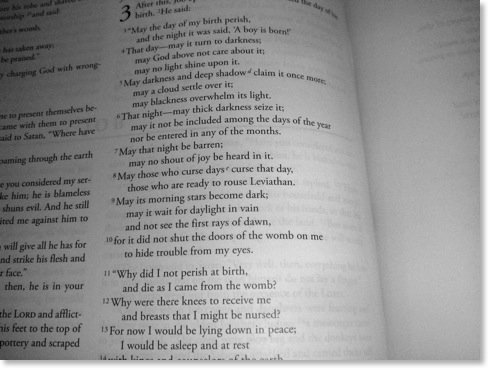
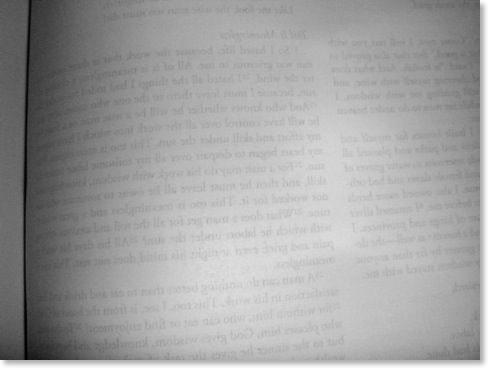
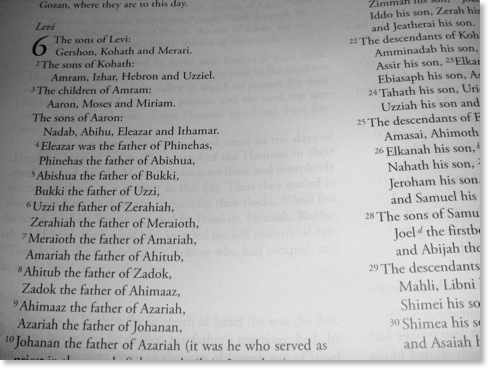
(b) Tiny font. The font size of the Little Oxford Bible is just five point, but the font size of the Noteworthy NIV appears to be slightly smaller than that. Thanks to my near-sightedness, I can read the Little Oxford Bible without magnifying glass, but I can't say the same Noteworthy NIV.
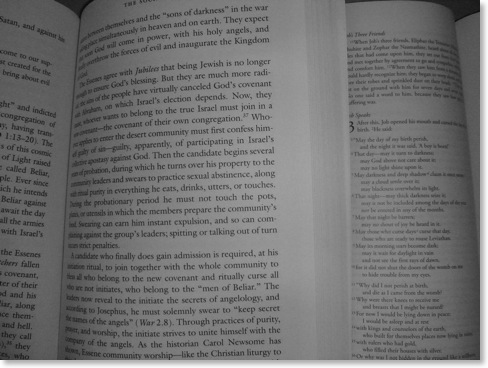
(c) Relatively generous inter-line spacing. Double column. Square size.
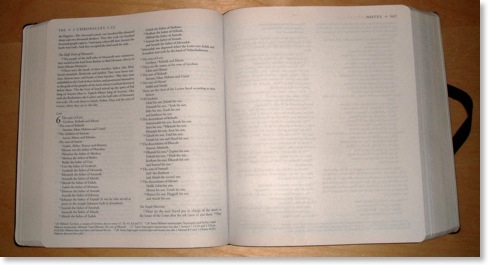
(d) Binding claims to be bonded leather but feels like slightly stiff paperback to me. No one would confuse this with a moleskin notebook.
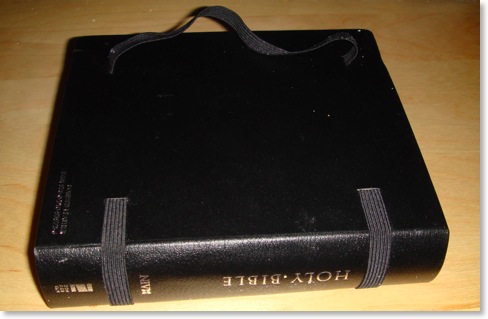
(e) The elastic on the the outside binding makes it look like this binding is designed to fail! It also give the bible a slight fetishistic look -- maybe it is designed for folks who like to wear latex and elastic.
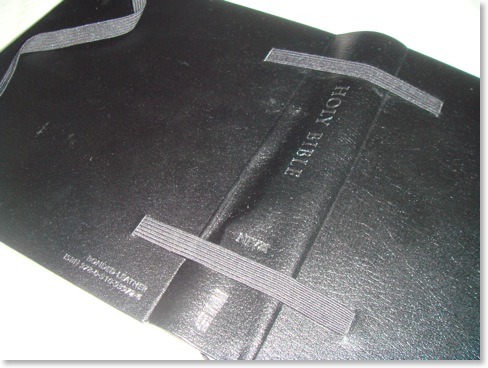

(f) The internal paper pocket on mine is already failing and I haven't put anything in it.

(g) The left top margin has the page number, an ugly 4-fold diamond mark, the book, name and chapter/verse, but the right top margin only says "notes", the diamond mark, and the page number, making it somewhat more difficult to find sections than one might desire. On the other hand, bleed-through on the Bible is so bad that one can simply read the mirror-image of text on the next page.
(h) No bonuses (no maps, no concordance, no cross-references, no book introductions) except for a half-page table of weights and measures.
All-in-all, I can see no use for this volume except as a fashion accessory among the Goth set.
A Horse Bible? Really?
What girl doesn’t love horses? Filled with beautiful features and photographs, horse lovers will be inspired by this NIV Bible
Really?
Note that I’m posting this on April 7, not April 1. Seriously.
The Wild About Horses Bible is aimed at girls ages 9-12. So, let’s get this straight: we have soldiers’ Bibles, nurses’ Bibles, firemen’s Bibles. And now we have little-girls-who-love-horses Bibles.
Really?
And yet, after four years, I still can’t get a wide-margin TNIV!
Is the niche for a horse Bible really greater than the one for a wide margin TNIV Bible? Really?
I mean, I’ve asked for a wide-margin TNIV for a number of times. I know lots of other people who have, too. But we’ve always been told the potential market for such a Bible simply isn’t big enough. So do you mean to tell me that a larger number of girls ages 9-12 have been beating down Zondervan’s doors for a horse Bible? Really?
Maybe there’s warrant for a Bible like this. Technically horses occur 200 times in the NIV. Of course, goats occur 173 times and sheep show up 208 times. When will we get a sheep Bible, too? Seriously?
Thanks to Jay Davis for alerting me to this.
Worthy of Note 01/30/2008
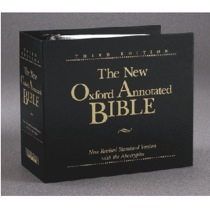
Says Iyov:
So, with all that extra page space, there is plenty of room for making ample annotations. The paper is significantly thicker than typical Bible paper, so there is much less bleed through from a pen. And, I can add extra paper anytime one wants (in the fashion of Jonathan Edwards' Blank Bible). If I make a mistake, I can always remove the page and replace it with a photocopy from my bound edition of the NOAB. If I want to slip in an entire article, or a copy of a page in original languages -- there is no problem. It seems to me that this is the ultimate in flexibility.
I'm glad to see this finally released, although I doubt I'll personally buy one. Regardless, I've got a number of larger blog projects I'm working on, one of which is an update to last year's survey of wide-margin Bibles. I'm glad that I'll be able to include an entry for the NRSV this year.

But we find ourselves at a point in history when we've never had so many choices, and yet the options are mostly arrayed along a horizontal spectrum -- a thousand different flavors of the same basic thing. I'd like to see more vertical choices, and that might require a shift in perspective. Instead of speaking to end-users as consumers, we might have to start thinking of them as readers.
What is most significant in the post is Bertrand's five-point "Starting Points for Marketing High-End Bible Editions." I can only hope that publishers will pay attention.


My esteem for White dropped significantly a few years ago due to the way he handled a theological disagreement with another individual whom I respect very much. I felt his approach to the issue was uncharitable, far too public, and lacking in the kind of collegiality that should characterize Christian scholarship. Nevertheless, White is usually in natural form when he is engaged in formal debate. However, I often believe that White is rarely pitted in his debates against opponents who are equally skilled. At the very least, Ehrman should provide a worthy opponent to White and this is a subject in which both are well-versed.
Christianity Today has released its list of the "10 Most Redeeming Films of 2007." Some entries on the list may surprise you, but it's a very good list. I remember when we used to do more movie reviews and discussion around here.
Finally, in the I JUST DON'T GET IT DEPARTMENT: 2008 marks the 30th anniversary of the New International Version of the Bible. I've seen references on two other blogs (see here and here; oh, and also here) that Zondervan is planning a special wide-margin, high-end leather edition of the NIV Study Bible as one of the many ways that the NIV's 30th anniversary will be celebrated.
This is in spite of the fact that so many of us have asked for one decent wide-margin edition of the TNIV (the so-called TNIV Square Bible is flawed in three areas: (1) it's paper is too thin for annotations because it is a thinline, (2) the user doesn't have wide margin access to the inner column of text, and (3) the binding is subpar). If the TNIV is truly an improvement to the NIV (which I honestly believe it is), then why does Zondervan (and IBS, Cambridge, and Hodder) keep pushing the NIV and publishing new editions? If in ten years the TNIV turns out to be an also-ran translation, it will only be because publishers didn't know how to fully transition away from the NIV.
My suggestion for celebrating the NIV's 30 year anniversary? Retire it. (My apologies to everyone I just offended, including my friends at Zondervan.)
I would like to find simply ONE decent wide-margin, high quality (see Bertrand's post above for the meaning of high-quality) Bible in a contemporary 21st century translation (HCSB, NLTse, TNIV, or NET). I'm still writing down notes in my wide margin NASB95, but the first translation of those I've listed that is released in a single-column, non-thinline, wide-margin edition, I will make my primary translation for preaching and teaching for the next decade. You heard it here first.
First Look: A Reader's Greek New Testament, Second/Revised Edition
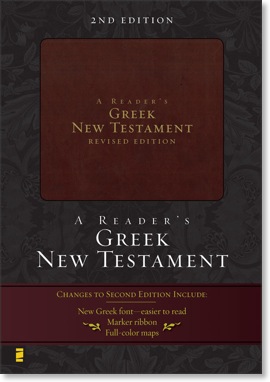
SOME BACKGROUND: THE FIRST EDITION
I've always found A Reader's Greek New Testament (RGNT from this point forward) to be an extremely practical resource. The RGNT addresses the issue that while there are over 5,000 distinct words in the Greek NT, the reality is that many of this words only occur a few times or even in single occurances. While it's an admirable goal for a student of Greek to memorize every word, it's not a reality for most. Most introductory grammars, in fact, only cover a little over 300 words, but these words occur so frequently that they account for roughly 80 of the entire New Testament. But that remaining 20% is still enough from keeping the average person who has a familiarity with Greek from sitting down and reading the New Testament in its original language as easily as one might read an English translation. In fact, in my experience and observation, I've known personally of only about two or three people who can really read the Greek NT without stumbling. Oh, sure, the dirty little secret is that any of us can read a passage just fine when we've taken the time to work through it ahead of time. But as soon as someone asks us a question about a different passage--one that we haven't prepared beforehand, we stumble and stammer as we try to read it in a quick and efficient manner.
The RGNT is noted for including lexical forms for all words of the Greek New Testament that occur 30 times or less. If this sounds like a crutch, think again. The reader still has to know his or her Greek grammar fairly well to use this resource. In fact, I tend to carry the first edition of the RGNT with me to church on Sundays. If I need to look up something quickly, and come across a word that's not part of my working vocabulary, I can look at the footnote at the bottom of the page. It's not realistic for me to carry a lexicon with me to church, and I usually don't have my MacBook so that I can access such tools in Accordance. Perhaps one day, I'll make time to memorize all 5000+ words in the Greek NT, but for right now it's not a practical goal and the RGNT is an ideal solution.
The other distinct feature of the RGNT first edition has to do with its textual basis. Most might assume that this is simply an edition of the current UBS/NA eclectic Greek text with a special apparatus. Not so. The Greek text in this edition is actually one that has been retrofitted, so to speak, to match the text that underpins the New International Version. The reality is that every translation committee makes decisions that sometimes causes them to choose a different textual route than the majority opinion of the UBS/NA committees. The RGNT first edition has about 200 instances, all noted in the footnotes, where its text differs from the standard text.
IMPROVEMENTS/CHANGES IN THE SECOND EDITION
New Greek font. I don't know if the font itself is actually a different font, but the main difference from the first edition is that the text in the second edition is not in italics. And I say, "Thank goodness!" My major complaint about the first edition of the RGNT is the italicized text that is extremely difficult to read. I have no idea why some publishers of Greek texts like to do this. The UBS 4th edition Greek NT uses a horribly thin italicized text also making it difficult to read. Thankfully, Zondervan changed this policy in the RGNT 2nd edition.
However, the font itself does look slightly smaller than the original edition. I've made a comparison in the graphic below that displays the first page of Matthew's Gospel on the left in the first edition and with the second edition on the right (note that the image below is not actual size).
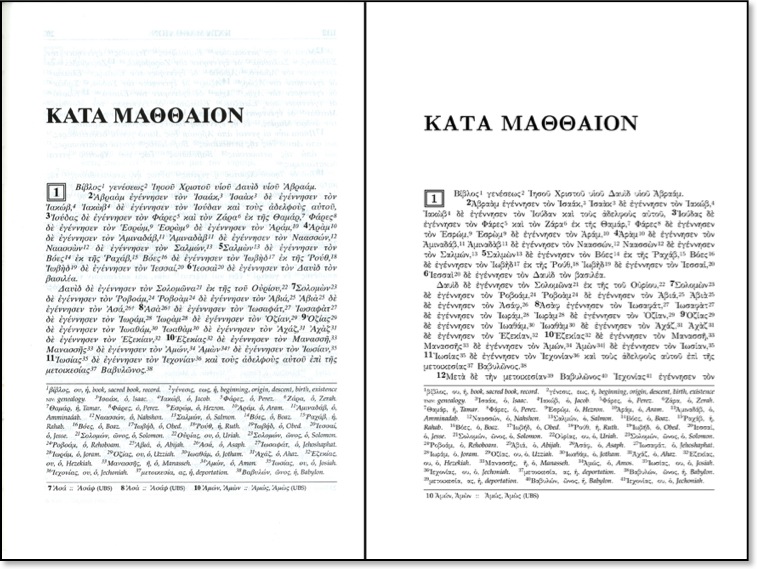
The observant reader may notice that there's slightly more text (most of Matt 1:12) on the second edition page. Therefore, the font is either tighter or smaller. Zondervan offers a PDF sample of the RGNT2 featuring the first five pages of Matthew. The second edition ends with Matt 3:17 while the equivalent page in the fist edition ends with 3:15. Two verses--is that a big deal? Probably not, but there is definitely an attempt to use fewer pages. Why? Because while there are more features in the RGNT2, but there are actually fewer pages than the first edition. Therefore, an attempt was made to conserve space. And while I wish Zondervan had not chosen to use a tighter/smaller font, I will say that regardless, the new text is much easier to read than the italicized text of the first edition.
But that brings us to another issue, and frequent readers of This Lamp will have to pardon a familiar complaint that I've discussed many times before. This New Testament, (presumably) like its predecessor is a thinline. How do I know this? Well, in spite of the fact that complete measurements have not been released, we do know a few things. I'm guessing the dimensions are a bit wider because the outer margin on each page is wider (see more below). We also know that although there is about a twenty page difference in the two editions, the weight is comparable (1.065 lbs. for the first edition vs. 1 lb. for the second edition). Thickness measurements for the second edition have not been released, but the first edition is 7/10 of an inch thick. Since the two editions weigh virtually the same, I can only assume that the second edition will be just as thin.

Personally, I hope that one day, publishers will get over their infatuation with thin Bibles and realize that the target market for a resource like this does not mind having a book that is somewhere between one inch and one and a half inches in thickness. I'm sorry, but cramming 576 pages into 7/10 of an inch is ridiculous.
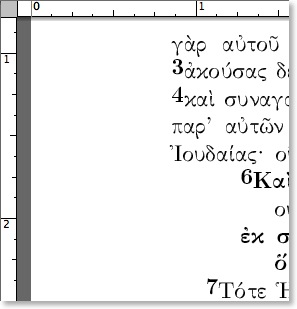
Again, this is an area where I with publishers would realize that those who buy products such as the RGNT appreciate not just thicker paper, but also wide margins for making notes, Regardless, whereas, the first edition's anemic margins were useless for any annotations, the new wider margins begin to approach a minimum width for note-taking,
Mlnl-Lexlcon. For those occasions when the reader forgels one of those words that occur more than 30 times, a new mini-lexicon has been added, presumably in the back of the RGNT.
Maps. Four new color maps have been added to the second edition of the RGNT. Already UBS/NA Greek New Testaments tend to have basic contextual maps inside the front and back covers. With the addition of these maps to the RGNT, this resource begins to take the feel of a standard reference tool and even a one-stop instrument for public use.
And the rest. Like the first edition, the new RGNT comes in an Italian Duo-Tone binding, I've stated before that I like this material just as much as actual leather. Assuming that these covers are going to hold up over decades-long use, I find them to be a very adequate substitute for real leather, especially if this keeps the price down. Perhaps Zondervan could put a disclaimer on the copyright page: "No cows were harmed in the publishing of this New Testament."
And of of course, the RGNT second edition will continue to offer lexical forms of words that occur less than 30 times in the Greek NT as well as noting where the text diverges from the UBS/NA texts. I'm pleased that they continue to keep these notes on the same page as the NT text, in footnote fashion, rather than by some other means.
I'll have more to say about the RGNT2 after I get my hands on one in November, Butfrom what l can already determine, it is already looking to be a great improvement over what was already a very practical and useful resource.
iPhone Bible App Roundup: July 2007
Let me say up front that on the iPhone, there's nothing like the kind of offerings Olive Tree has for other PDA's and smartphones. In fact, I contacted Olive Tree to see if they were working on any kind of solution for the iPhone. They asked me if I would be interested in testing the text files they offer for iPods on my iPhone since no one at Olive Tree actually has an iPhone. I had to inform them that text files cannot be placed on an iPhone in the same manner that one can on an iPod because the free space on the iPhone's flash drive cannot be directly accessed. At this point, I don't know where Olive Tree's strategy stands for the iPhone, if there is one at all.
A major drawback of the iPhone is that Apple will not allow third party applications on the iPhone at this point. Now, I've heard rumors that a software development kit is in the works, but supposedly the Windows version isn't up to speed with the OS X version at the moment, so Apple wants to wait until the SDK's have platform parity before either is released. These days, Apple Inc. (no longer Apple Computer) has quite a few Windows software offerings and actually sells more iPods and iPhones to Windows users than to Mac users. Until the Windows SDK is up to par, we have no third party apps. Again...if this rumor is true at all.
The solution, and one endorsed publicly by Apple, revolves around Web 2.0 apps that can run in the iPhone's stripped down Safari browser. Quite a few "programs" have been released so far and are cataloged at websites such as The iPhone Application List. Some of these applications are quite handy, but in the interest of myself and readers of this blog, I thought I would try to create an ongoing series regarding the Bible offerings for the iPhone as they become available.
Currently, there are three iPhone applications that offer access to the Bible. I will offer brief reviews of them in the order they were released.
iPhone Scriptures/LDS Standard Works (KJV & Mormon)
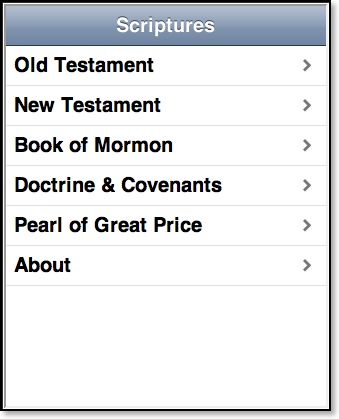
Technically, these are two separate programs, but they use a similar interface, so I'm going to assume there's some connection between them. Released about a week after the launch, iPhone Scriptures was the first Bible related app available for the iPhone. The interface is straightforward. Clicking on a selection such as "New Testament" offers the user a list of New Testament books. Selecting a book takes the reader to another screen with chapter numbers. Selecting a chapter yields the entire text for that chapter:

The button at the top of the text that says "Library" takes the reader back to the initial screen. What seems to be an obvious omission are arrows that would take the reader to the previous or next chapters. No search features are present, but it's promised to be available soon. In case you didn't notice, the biblical text is limited to the King James Version, which is the officially used translation of the Mormon Church. This isn't surprising, but will certainly limit widespread use of this program.
The only functional difference between iPhone Scriptures and LDS Standard Works is the ability to turn off the Mormon Scriptures in the latter program for those who don't want to look at the Mormon-specific titles. This is done in a "Settings" tab at the bottom in place of the "About" tab in iPhone Scriptures.
I saw iPhone Scriptures within a day or two of it's release, and the initial interface had very tiny tabs making it virtually unusable. The current version is much improved.
3onesix Ministry Tools (NIV)
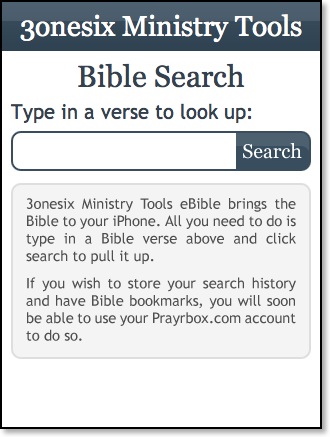
This Bible was released around July 10, and takes a slightly different approach to accessing the Scriptures than the programs mentioned above. In 3onesix Ministry Tools, the user must know what passage he or she wants to view in advance. For instance, typing "Matthew 1" results in that chapter being displayed.
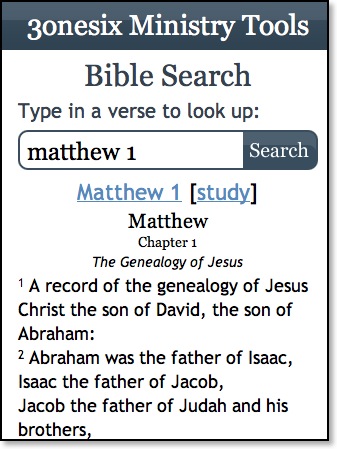
Clicking either of the links on the chapter screen takes the user to the regular eBible website which is what this program is based on. Currently, the only text available from 3onesix is the NIV, but one would hope that others would eventually be made available since eBible offers multiple versions. At the moment, unless the user goes to the eBible site, there is no direct search feature in the app specifically made for the iPhone.
iBibleSpace (ESV)
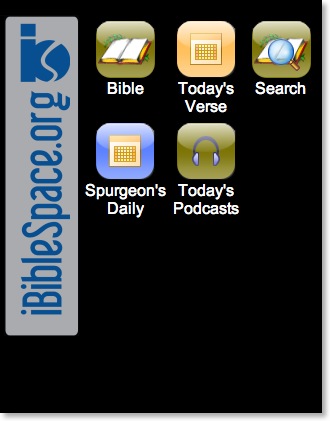
By far the most impressive iPhone Bible app to date is iBibleSpace released a couple of days ago. Anyone who has already spent time on an iPhone will immediately recognize an interface that draws its cues from the regular iPhone home screen. By choosing the first option, "Bible," one is presented with a similar interface as found in the original iPhone Scriptures application mentioned above, but it's designed to look much better in iBibleSpace. Again, the user can select a book of the BIble (OT & NT books are on the same screen), and then a chapter.
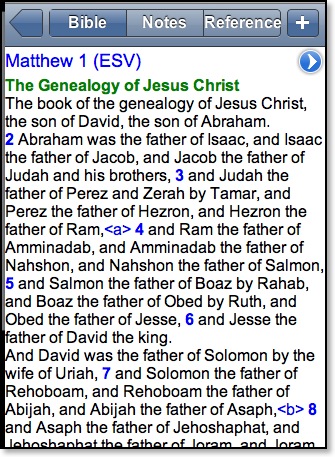
The text as shown above is quite clear, and contrary to the screenshots I took above on my MacBook (I don't know of any way to grab screens on my iPhone), the text such as the word "Reference" above fits perfectly onto it's button on the iPhone.
iBibleSpace has quite a few features going for it that puts it ahead of the other two iPhone Bibles. First of all, the ESV text as shown here includes access to textual footnotes: notice the "" at the end of v. 3. That note designation is actually hyperlinked and will take the user to the bottom of the screen where the footnotes all appear at the end of any chapter. You might also notice the right-pointing arrow that will take the user to--you guessed it--chapter 2 where there are both previous chapter and next chapter buttons.
A number of other options are offered at the top of the screen as well. The large single-colored left pointing arrow will take the user back to a listing of all chapters in the biblical book. The "Notes" button allows the reader to access a personalized account where one can store customized notes. The plus (+) button on the far right allows the user to add a new note and even highlight a verse in one of six different colors [gee, maybe I could transfer all the notes from my wide margin NASB to my iPhone!...or maybe not]. The "Reference" button takes the user to notes from Matthew Henry's Concise Commentary (not of great interest to me, but it's a nifty feature, nonetheless).
The only real downside I saw of the biblical text in iBibleSpace was the dreaded words of Christ in red. If this "feature" could be turned off, I believe that would be helpful to many.
Going back to the IBibleSpace main screen is simple because it always remains as a separate page/tab in the iPhone browser (in case you didn't know, the iPhone will allow the user to have multiple pages open at once, much like tabs in regular browsers). "Today's Verse" is just what you would expect it to be: a daily Bible verse. There is a link to read the entire chapter from which the verse comes in context if one is so inclined.
Another distinguishing feature of iBibleSpace is its search feature:
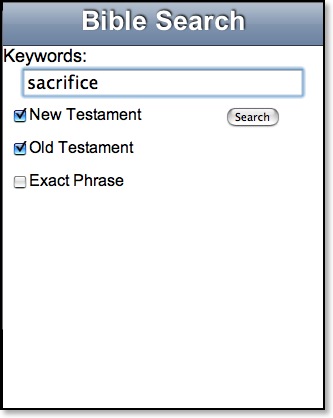
One can search either or both testaments and exact phrases. Results are displayed in groups of five at a time with an option to select "More."
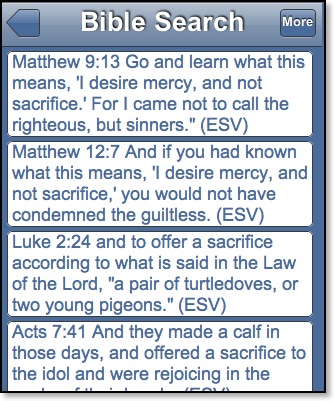
However, I found it odd that NT hits are listed before OT results. I would prefer them my results to be listed in canonical order. Further, in most Bible programs the search word is usually highlighted in some way, but not so in iBibleSpace.
The other two buttons on the home screen will lead the user to daily devotions from Spurgeon or podcasts from a variety of conservative Christian radio shows. The selections are a bit odd in my opinion. I cringed when I saw Joyce Meyer, but I occasionally enjoy listening to Ravi Zacharias' show. The great majority of the offerings, however, I would not have any regular interest in. I also doubt I'd run to my iPhone for a daily devotional from Charles Spurgeon either. In fact, it seems odd to me that it's a primary button on the home screen.
Regarding the podcasts, though, I followed one all the way to the show to see if the iPhone would actually play it. The link was to an MP3 file that launched QuickTime on the iPhone. I think that was the first time that I realized that I even had QuickTime on my iPhone!
iBibleSpace is impressive on many levels: features, design, and consistency of its interface (one never follows a link that leads to a page not formatted to the iPhone unlike the 3onesix app). Even though the ESV is not one of my preferred translations, I put iBibleSpace at the top of my iPhone app bookmarks. At the present time, iBibleSpace is far and away the best Bible app available for the iPhone.
I'd still like to see original language texts on the iPhone, although I have no idea if the iPhone would even support Greek and Hebrew fonts. Of course one would presume that it is using Unicode fonts already. Something like the NET Bible would be interesting to have on the iPhone as well, and perhaps because the folks behind the NET have been so Internet savvy, we will see something in the near future. One also wonders if an iPhone interface to something like Bible Gateway couldn't be created to take advantage of multiple translations.
Further, I still am hopeful for third party apps. The major drawback of any of these apps relates to their dependence on the Internet. Even with a WiFi connection, they are not as fast as a native application would be.
In the meantime, three weeks have yielded three distinct Bible apps of varying creativity and features. As others will undoubtedly come available in the weeks ahead, I'll be sure to cover as many as possible here on This Lamp.
TNIV Truth: Habakkuk 1:12 Revisited: The TNIV Angle
TNIV Truth: 1 Peter 4:12
TNIV Truth: NIV vs. TNIV: Matthew 11:12
Zondervan's NIV Archaeological Study Bible Revisited: New Printing Corrects Some Errors, But Leaves Others
In fact, because of my enthusiasm for the ASB, my wife and I purchased one for my brother-in-law last week as a Christmas present. While taking a copy off the shelf in the store, I immediately noticed that the dust jacket was the same height as the entire volume. Remembering that the dust jacket on my copy had been more of a wrap-around cover, I wondered if corrections had been made to the copy I held in my hand. I quickly turned to p. 101 to see if the Rosetta Stone was turned right-side up. It was! However, something still did not look right. More about this below.
The new printing (recognized by a full-length dust jacket in the hardback) should not be mistaken for a new edition of the ASB. Bibliographies for further research are still missing, and a few things have been changed, but unfortunately other things have not. The list below should not be considered a complete one, but rather my checks on the issues discussed in the comments of my previous review. It should be noted that Zondervan was made aware of the issues in my last post of the ASB and the comments pertaining to it.
- The front matter now includes a list of article contributors which was missing from the original edition. Articles are still not signed, but at least the contributors, many of which were graduate students are now given credit. However, I can no longer find their names or even the names of the editors on the ASB website., although the link included in the comments of my previous review still works. If I am overlooking a link still on the ASB site, someone can correct me.
- The spelling inconsistency of "mikveh" (p. 1648) and "miqveh" (p. 2085) remains. Neither one is incorrect, but usually in a work like this a consistent spelling will be adopted. Obviously, this is a minor issue, but I'm surprised it has not been caught.
- William Hallo's name is still misspelled as "Hallow" on p. xviii (p. xix in the original edition). I double-checked my own copy of The Context of Scripture yet again, and the name is indeed misspelled. This should have been a prioritized correction.
- The Masoretic Text in the glossary listing on p. 2085 is still listed as being housed at the Saint Petersburg Public Library, but this title is slightly incorrect. Technically the manuscript is housed in the Russian National Library (or the State Public Saltykov-Shchedrin Library), which technically is a public library in Saint Petersburg, Russia.
- Something I hadn't noticed before, and is probably picky to some, but Dr. Duane Garrett (who served as General Editor and Theological Review) is associated with the "Southern Baptist Seminary" on p. xviii instead of the "Southern Baptist Theological Seminary," the actual name of the school.
- Now about that Rosetta Stone on p. 101--good news and bad news. The good news, which I have already mentioned, is that the Rosetta Stone in the new printing is now right-side up:

In the photo above, I have laid the first printing on the left next to the recent printing on the right. In the original edition of the ASB, the Rosetta Stone was incorrectly placed upside down. The new printing places it right side up. But when I first looked at the "corrected" image while still in the store, something bothered me; something didn't seem right. When I got home I looked up the Rosetta Stone in a few of my own resources. Sure enough--it's still not correct. The picture in the book is actually a mirror image of the original Rosetta Stone. Compare, for instance, this image from the website of the British Museum where the stone is kept:
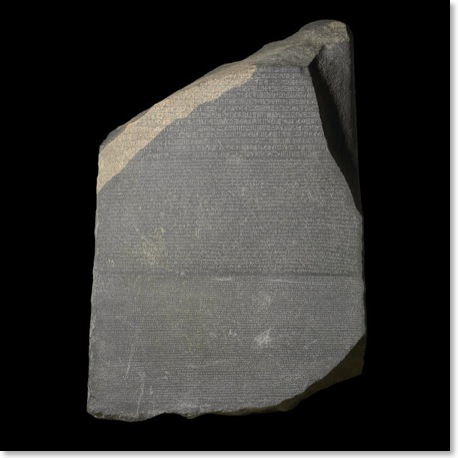
Obviously, the original blunder was worse, but one would think that an artifact as well-known as the Rosetta Stone could be displayed correctly.
In spite of these issues, I'm still very enthusiastic about the Archaeological Study Bible. I own one myself, and I just bought one as a Christmas present. However, before the next printing of this Bible, hopefully someone can really give it a fine-tooth proofread. This should probably be an expert in the field of biblical archaeology and backgrounds who did not work on the original project. It's often quite hard to proofread one's own mistakes because one knows how the work is supposed to read (happens here on my blog all the time).
One more thing... before posting this blog entry, I contacted Zondervan almost a week and a half ago to see if there was a complete list of corrections and changes available for this new printing of the ASB. Unfortunately, I have not heard from them yet, but if I find out there are more corrections, I will post them here.
The Evolution of John 1:18 [UPDATED]
| John 1:18 in the NIV Tradition | |
|---|---|
| NIV (1978) | No one has ever seen God, but God the only* Son,** who is at the Father's side, has made him known. Notes: *Or but God the only begotten **Some manuscripts but the only Son (or but the only begotten Son) |
| NIV (1984) | No one has ever seen God, but God the One and Only,* **who is at the Father's side, has made him known. Notes: *Or the only begotten **Some manuscripts but the only (or only begotten) Son |
| NIrV (1996; 1999 revision reads the same) | No one has ever seen God. But God, the one and only Son, is at the Father's side. He has shown us what God is like. No notes. |
| NIV (Inclusive Language Edition, released only in UK, 1996) | No-one has ever seen God, but God the One and Only,* **who is at the Father's side, has made him known. Notes: *Or the only begotten **Some manuscripts but the only (or only begotten) Son |
| TNIV (2005) | No one has ever seen God, but the one and only Son, who is himself God and* is in the closest relationship with the Father, has made him known. Note: *Some manuscripts but the only Son, who |
The textual issue here is well known. Older translations used the phrase "only begotten Son" [μονογενὴς υἱός] but with the discovery of p66 and p75, many later twentieth century translations began using "only begotten God" [μονογενὴς θεὸς]. In Metzger's Textual Commentary (I have the 3rd edition; someone let me know if later editions read differently) the latter reading is given a B rating because p66 and p75 are older and μονογενὴς θεὸς is undeniably the more difficult reading. A concise but thorough explanation of the issues is found in the NET Bible notes. Interestingly, the HCSB is the only contemporary translation I've come across that reverts back to "one and only Son" [μονογενὴς υἱός].
The transitions in the NIV tradition are interesting because in the original 1978 edition, both Son [υἱός] and God [θεὸς] were incorporated into the text, although this was dropped in the NIV's final form (1984) in favor of the more accepted μονογενὴς θεὸς. And although the Inclusive Language Edition of the NIV in 1996 made no changes to the 1984 NIV regarding this verse, a year earlier, the NIrV went back to the 1978 NIV's incorporation of both textual traditions. Both traditions are also incorporated into the TNIV, although the emphasis surprisingly seems to be on the later textual tradition, μονογενὴς υἱός, translated as "the one and only Son."
I'd really be interested to know the reasoning behind using both "God" and "Son" in the rendering of the verse. Although the TNIV.info website offers a rationale for the wording in John 1:18, it's not specific enough to fully address this issue.
Incidentally, a number of other translations have also incorporated both Son and God into their rendering of John 1:18 including the REB, NRSV, NLT, and GWT, so the TNIV is in good company. However my only problem with using both traditions in the verse is that a translation has been created which could not possibly be reflected in any ancient manuscript. I'd be interested in anyone's insight into this issue.
Update (10/23, 9:30 AM): Be sure to click the comments link below for a solution to this problem by Suzanne McCarthy (whose mastery of Greek is far superior to mine). She says that the translations are not combining two textual traditions at all, but rather
Monogenes by itself is considered to be the "only son." It is read as a noun not an adjective in this verse. Have a look at John 1:14. So no one is combining two readings of a manuscript, at least not this time.
Be sure to read her entire explanation in the comments below. I do remember reading that μονογενὴς by itself could be rendered "only Son," but I didn't grasp that this is what the TNIV translators were doing in this verse. And I still find it very interesting that they delivered a similar rendering in the very first edition (1978) NIV, and then moved away from it by the 1984 release. Surely those debates must have been interesting. And obviously, this way of rendering John 1:18 is not a fully accepted solution since there is not agreement among all recent translations, but there is certainly an overwhelming consensus.
For the sake of comparison, here is the full Greek text for the verse for reference and the translations that have used similar renderings to what is done in the original NIV and TNIV:
Θεὸν οὐδεὶς ἑώρακεν πώποτε· μονογενὴς θεὸς ὁ ὢν εἰς τὸν κόλπον τοῦ πατρὸς ἐκεῖνος ἐξηγήσατο.
________________________
No one has ever seen God; but God's only Son, he who is nearest to the Father's heart, he has made him known (NEB, 1970).
No one has ever seen God, but God the only Son, who is at the Father's side, has made him known (NIV, 1978).
No one has ever seen God; God’s only Son, he who is nearest to the Father’s heart, has made him known (REB, 1989).
No one has ever seen God. It is God the only Son, who is close to the Father’s heart, who has made him known (NRSV, 1990).
No one has ever seen God. The only Son, who is the same as God and is at the Father's side, he has made him known (GNT, 1992)
No one has ever seen God. God’s only Son, the one who is closest to the Father’s heart, has made him known (GWT, 1995).
No one has ever seen God. The only Son, who is truly God and is closest to the Father, has shown us what God is like (CEV, 1995).
No one has ever seen God. But God, the one and only Son, is at the Father's side. He has shown us what God is like (NIrV, 1996/1999).
No one has ever seen God. But his only Son, who is himself God, is near to the Father’s heart; he has told us about him (NLT1, 1996)
No one has ever seen God. But the one and only Son is himself God and is near to the Father’s heart. He has revealed God to us (NLT2, 2004).
“No one has ever seen God, but the one and only Son, who is himself God and is in closest relationship with the Father, has made him known (TNIV, 2005).
________________________
Translations rendering μονογενὴς as an adjective modifying θεὸς (this cannot be called a "traditional" rendering because it only occurs beginning in 20th Century):
No one has ever seen God, but God the One and Only, who is at the Father’s side, has made him known (NIV, 1984/1996).
No one has seen God at any time; the only begotten God who is in the bosom of the Father, He has explained Him (NASB, 1995).
No one has ever seen God; the only God, who is at the Father’s side, he has made him known (ESV, 2001)
________________________
The only modern translation using the older (pre-p66 and p75) rendering:
No one has ever seen God. The One and Only Son--the One who is at the Father’s side--He has revealed Him (HCSB, 2004).
The NIV Archaeological Study Bible: A Review
I served for five years as a chaplain and Bible teacher at a Christian high school. Whenever I got new groups of students, I always had to explain to them that our study of the Bible was not going to be like a Sunday School class where they showed up and heard nice stories. I informed them that our studies would be rooted in the surrounding history of the Bible because God's Word wasn't written separate from the culture where it originated. I especially liked it when I got comments such as "Hey, we've studied this in World Civ, too!" I've always felt it was important to connect the Bible to the history that surrounded it.
One of my graduating seniors, who had taken my classes for a couple of years, remarked, "Mr. Mansfield, I bet if a three-year-old was sitting in your lap and asked you why the sky was blue you would say to him, 'Well, first you have to understand the meaning of "sky" and "blue" from the viewpoint of ancient Mesopotamians in relation to their religious and political backgrounds. Only then will you begin to understand....'" I took that as a compliment. And this is why I like the ASB. Don't tell anyone, but at some point over the years much of my interests in biblical studies has shifted from theological priorities to those of a historical nature. Perhaps this is because I came to recognize that many of the theological errors that have come from some interpreters over the centuries are rooted in historical misunderstandings of the context(s) in which the Bible was written. The ASB will go a long way in preventing such errors.
The ASB is essentially a project from Gordon-Conwell Theological Seminary and published by Zondervan. Walter Kaiser is listed in the colophon (p. 2307) as the executive editor, and Duane Garrett (now at the Southern Baptist Theological Seminary) as the general editor and in charge of theological review. From what I've overheard, the bulk of the ASB was done by Dr. Garrett. The "About this Bible" section (pp. xii-xiii) at the beginning of the ASB demonstrate the purpose and value of this work:
The NIV Archaeological Study Bible focuses on the historical, literary and cultural context of the Bible. This context includes the history of people and places populating its pages, daily life in various periods and under widely diverse circumstances during Biblical times, and ancient texts that illuminate the Bible and the archaeology of the Biblical world. In addition the articles in this Bible devote particular attention to challenges archaeologists and Biblical scholars face on the critical issue of the trustworthiness of Scripture.
...
Many modern Christians shun the study of the ancient world for fear that scholars will make them aware of troubling facts that will serve only to undermine their faith in the Bible. In reality a careful study of the world of the Bible enhances our confidence in its historical accuracy and in its distinctiveness as the Word of God.
...
Further, many well-intentioned Christian readers, although not fully committed to a postmodern way of thinking, tend to interpret the Bible strictly in terms of their own experiences and standards, without ever considering what a prophet or apostle was saying to the people of his own day. An awareness of the beliefs conflicts, history and habits of the people of Biblical times forces us to confront questions like, "What did Paul actually mean when he wrote these words to the Corinthian Church?"
The ASB is a wealth of historical, cultural, literary, and archaeological information about Bible times. First there are 8,000 notes running along the bottom of the page like any regular study BIble. Most of these are a subset of the notes--specifically the historical and cultural notes--that run in Zondervan's NIV, NASB and TNIV Study Bibles. I would assume there may be some additional notes as well, but I didn't perform an in-depth comparison with the older works. But the study notes aren't where the strength of this Bible lies. Of immense value is collection of 500 short articles which are organized along the subcategories of archaeological sites, cultural and historical notes, ancient peoples and lands, reliability of the Bible and ancient texts and artifacts.
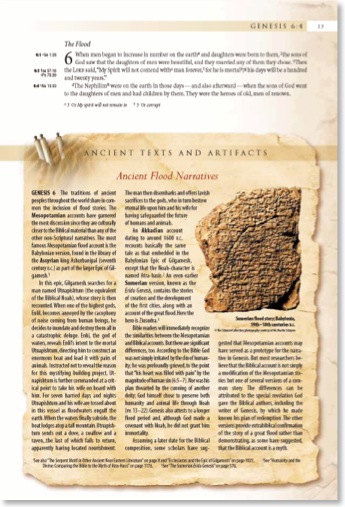
The average study Bible is aimed at a popular audience, and it's value is usually in it being a one-stop reference source. The ASB seems to be a step above the average popular study Bible, but that does not mean that it would not be accessible to the average Christian. In my experience teaching adults, I've found that there's great truth in the fear of delving into historical backgrounds because of some risk of undermining one's faith. I remember teaching a Sunday School class once where I suggested as a means of strengthening their faith that they read some non-biblical religious texts. There was almost a unanimous refusal to even consider this suggestion because they were afraid that it might make them doubt their faith. The ASB is not afraid to confront these issues and in fact shows the value of doing so. There are articles in the ASB on non-Biblical creation myths and flood stories. The documentary hypothesis receives full article treatment. And yet all this is done from a conservative-evangelical perspective with the goal of strengthening the reader's faith in the reliability of the Scriptures.
For me, I have no doubt that I have most, if not all of the information found in the ASB elsewhere in my library. But nowhere do I have this kind of information in one place so tightly tied to the biblical text as it is here. In my teaching, the ASB is a great first stop in research--much like the value of an encyclopedia. But also like an encyclopedia, this is a work that I can cheerfully become lost in. The articles are addictive--and there are 500 of them! Reading one is often not enough. I turn a page or two and there's something else that strikes my interest and I read that in some kind of biblical ADD response.
A few weeks ago, I gave myself a Saturday afternoon to sit in a local Starbucks and just explore the ASB to my heart's content. Some of what I write below came from my notes taken on that day, and some comes from my experience using this Bible as a reference in other teaching settings.
One feature of the ASB that I didn't mention above is the "Ancient Voices" that are scattered in the margins throughout the work. These are readings from genre-similar writings of the culture. At first it can be a bit odd to see pagan writings alongside biblical passages, but once the reader gets beyond this, he or she will be reminded that our Scriptures were not written in a cultural vacuum. When I was teaching from Song of Solomon a few weeks ago, I came across this ancient little ditty on p. 1036:
I will lie down inside,
and then I will feign illness.
Then my neighbors will enter to see,
and then my sister will come with them.
She'll put the doctors to shame
for she (alone) will understand my illness.
I love the mischievous playfulness in those lines, very much like the lines of the writer of the Song of Songs. There is a note at Song 4:9 explaining that sister "is a common term of endearment in the love poetry of the Ancient Near East," but unfortunately this explanation is six pages away from these lines. No doubt the uninitiated modern reader may not understand the use of sister in these lines and in Song of Solomon without this explanation. For my purposes, though, I wanted to know the source of the "Ancient Voices" lines. The only thing listed with the above-quoted passage was "Papyrus Harris," which did not tell me much. One might think the "Ancient Voices" segments would be listed or indexed somewhere in the back of the Bible. However, I finally found the source listed in the acknowledgments on p. xix. Although I thought this placement odd, I was delighted to see that the collection source for "Ancient Voices" comes from The Context of Scripture, edited by William W. Hallo and K. Lawson Younger. I was first introduced to these books a few years back in doctoral seminars with Daniel I. Block who always insisted that we must read Scripture in conjunction with other ancient literature.
In the front of the ASB there is an introductory essay on "The History of the Holy Land" which traces development from pre-Israelite culture through the modern day. Although the five-page article is brief, it will serve as a good introduction for many readers to the ongoing volatile nature of this region and the peoples who have inhabited it over the centuries. And if any reader is disappointed by the brevity of this article, perhaps this can be offset by the fact that the introductory article is cross-referenced throughout to many of the 500 other articles in the ASB. The introductory article also introduces the readers to the ASB's use of words in bold. Any word in bold in any of the articles is defined in a glossary at the back of the Bible. Unfortunately this bold highlighting is not applied to any of the 8,000 study notes, and I also noted that sometimes words listed in the glossary were not always bolded in the articles.
The ABS, like any good Bible, includes maps in the back--14 in all. Unfortunately, none of them are remarkable in any way related specifically to the other contents in this Bible. In fact, I believe they are just the same maps Zondervan includes in most of their other Bibles these days. I would have been interested to see perhaps maps of current archaeological digs, significant archaeological discoveries, important locations in Jerusalem, and even one detailing the proximity of the various Qumran caves to one another.
The map of the Exodus in the back only shows the "traditional" route (which is likely incorrect) and none of the other suggested routes in spite of the fact that the ASB contains excellent articles on other suggested routes of the Exodus: the northern route theory (p. 108), the southern route theory (p. 109) and the Arabian route theory (p. 112). Unfortunately no in-text maps display these routes, so it is left to the reader to plot these out alone. Related to this issue is an article (p. 123) that acknowledges disagreement by scholars on the exact location of Mt. Sinai (the traditional site which is the home of St. Catherine's Monastery is probably not the actual location). But again there is no map depicting alternative locations either in the text of the article or in the back of the Bible.
I admit that during my afternoon exploring and taking notes on the ASB, I ran out of time. Kathy came to get me before I got too far out of the Old Testament. But there is excellent treatment of the New Testament as well. For instance, there are articles on the Synoptic Problem and "Q" (p. 1685), the legend from the Middle Ages about the Needle's Eye Gate (it's thankfully debunked; p. 1594), the Pontius Pilate inscription (p. 1714), the use of the Septuagint in the New Testament (p. 1995) and so much more. Anyone interested in Greek and Roman history will especially appreciate many of the cultural articles in the ASB New Testament.
There are two main resources missing from the ASB that I wish it had. As I mentioned, study Bibles are good starting points for research or even good tools for quick reference. I wish that the editors had chosen to include bibliographies beyond merely the sources for which permissions were received. And it's really a shame that the NIV, the base text of the ASB, does not include the apocryphal/deuterocanonical books. Although I do not personally view these books as authoritative Scripture, they are important witnesses to the intertestamental time period, and I would have liked to have seen them get the standard ASB treatment. However, to the credit of the ASB, the subject index lists half a dozen articles strictly on the apocrypha and the intertestamental period just under the word apocrypha.
And truth be told, I don't see how the ASB could be any bigger than it is without going to two volumes. At two and a half inches thick and over four and a half pounds, it is easily the largest non-family Bible I own. However, it actually has fewer pages than the TNIV Study Bible. My hunch is thicker paper had to be used to accommodate the use of full-color printing. I have the hardback edition of the ASB (see Amazon link below), but it also comes in a variety of leather editions.
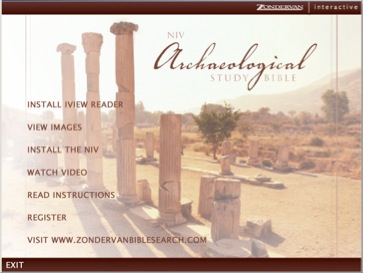
Of course, my greatest complaint about the CD is predictable if you know me--it's only for Windows! Don't tell Zondervan, but I was able to view it in Parallels Desktop on my MacBook, but it's not the same as running it natively. I don't believe that making the CD-ROM cross-platform would have been all that difficult. The CD's interface uses Macromedia Flash which is cross-platform already. The NIV text could have been included with Accordance Bible software for the Mac since Zondervan already partners with Accordance on a number of products. Finally, the Mac OS already includes its own image viewer, iPhoto. A simple script could have been used to import all the ASB image files into iPhoto. And that's what I did myself. I imported all 128 images into iPhoto and I even directed my system screensaver to the images. I'm already getting compliments from my students at IWU who want to know how to get that screensaver with biblical locations and artifacts!
Finally, I must say something about errors in the ASB. One of my readers has commented elsewhere that a number factual/technical errors througout this Bible. He said that in examining 12 pages he found 20 errors (or was that 12 errors on 20 pages?). I've done a couple of different Google searches, and I cannot find any definitive list of errors in the ASB, although I am not doubting that some errors in a work this ambitious must surely exist. The most egregious (to borrow a word used by someone else I pointed this out to) error I can specifically point to is an upside down Rosetta Stone on p. 101. This kind of error is a bit embarrassing, and maybe we can blame that on the graphic layout person
I have not taken the time to sift through the pages of the ASB and run fact checks. But my experience with this Bible so far makes me very enthusiastic about the project. I'm supportive enough to use it myself (it already has a permanent place on the shelf above my desk), recommend it to others, and we're even planning to give a copy to my brother-in-law for Christmas because he loves history (hopefully he's not reading this). I, too, love history and truly appreciate the application of it to the Scriptures as found in the ASB. The ASB would also make a great standard Bible for use in introductory New Testament and Old Testament courses in colleges and even seminaries.
I'll be interested to see if Zondervan eventually releases the Archaeological Study Bible in other translations besides the NIV, which is now almost three decades old. I'd be keen on a copy in the TNIV, and if it were released in a wide-margin edition, too...well, then I'd really be set.
Related: Archaeological Study Bible Website
NIV Wide-Margins on the Cheap
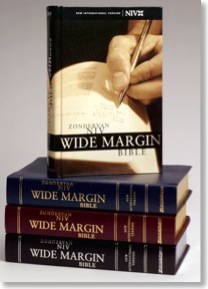
You can even choose which color you want: black, burgundy, or navy blue.
For those of you who like hardbacks, the NIV Wide Margin is only $22.99, although Amazon has it cheaper at $19.79.
Since CBD is known for making exceptional deals on items they often get as remainders, it makes for interesting speculation as to whether or not Zondervan is planning new editions of the NIV Wide Margin Bible. But who knows--maybe they're just overstocked. As I've said before, I'm still holding out for a TNIV Wide Margin Bible. Yesterday, I sent a link to my blog entry on what I want in a wide-margin Bible directly to Zondervan on their contacts page. I also suggested that they look at all the comments on that entry from all of you. So hopefully, they're listening.
Also, a few weeks back I reported that CBD had NLT1 Notemaker's Bibles on the cheap for $17.99. They've now dropped their black and burgundy bonded leather editions down to $12.99 and the hardback is $7.99. Holy frijoles!










